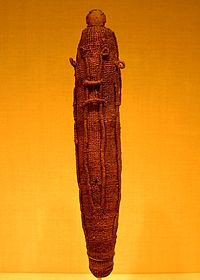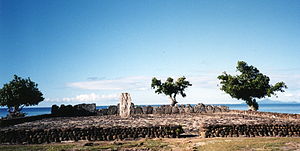- 'Oro
-
 A sacred god figure wrapping for the war god 'Oro, made of woven dried coconut fibre (sennit), which would have protected a Polynesian god effigy (to'o), made of wood. The mana of the god was symbolised by feathers, usually red in colour, which were attached to the surface of the woven covering. Figure held at the Metropolitan Museum of Art in New York.
A sacred god figure wrapping for the war god 'Oro, made of woven dried coconut fibre (sennit), which would have protected a Polynesian god effigy (to'o), made of wood. The mana of the god was symbolised by feathers, usually red in colour, which were attached to the surface of the woven covering. Figure held at the Metropolitan Museum of Art in New York.
'Oro is a god of the Polynesian pantheon. The veneration of Oro, although practiced in varying intensity among the islands, was a major cult of the Society Islands in the 17th and 18th centuries, especially Tahiti and Raiatea. On Tahiti 'Oro was the main deity and the god of war. The secret society of Arioi was closely linked because of its rites. On the Marquesas Islands, 'Oro bore the name Mahui.[1]
Contents
Origins
Four main gods were venerated on the Society Islands: Ta´aroa. originally the god of the sea and fishing, Tane, god of the forest and handicrafts, Tu, the old god of war and Ro´o, god of agricultural products and the weather. These main gods were also venerated on the other Polynesian islands.
The colonists who settled as part of the Polynesian expansion spread their religion amongst the various islands. Over the centuries the continual movement and developments of the original society groups brought about local differences and adaptations of the cult within the Polynesian Triangle.
On the island of Raiatea the priests elevated the god Ta´aroa from the role of sea god - already an important function in a maritime society - to the god responsible for creating the world. A possible explanation for this is that the ariki, the hereditary chiefs and members of the highest noble ranks on Raiatea, could trace their lineage directly to Ta´aroa. A further development of this cult was the veneration of Oro, the son of Ta´aroa and Hina tu a uta, to whom the marae Taputapuatea in the Opoa valley on Raiatea is dedicated. According to tradition, Taputapuatea is the mythical birthplace of Oro. The cult of Ta´aroa also spread to the Cook Islands, the Tuamotu Archipelago and Mangareva. Large islands, such as New Zealand and Hawaii, remained unaffected by the cult and its developments and Ta´aroa retains his original function there as god of the sea. [2] Similarly, on many of the other islands of the south Pacific Oro did not have the same superior function as on Tahiti and Raiatea.
Due to the growing influence of Taputapuatea - one can characterize it as a type of central pilgrimage site - Oro gained more political power and religious influence within the Polynesian pantheon. On the neighboring island of Tahiti the veneration of Oro grew in importance during the late proto-historical or early historical period and can be seen as a clear step from Polytheism to Monotheism. This development was substantially driven by the influential secret society of Arioi, who were of great religious and political importance. From within their ranks came the upper echelons of the nobility and the priesthood. The Arioi could trace the foundation of their order back to the god Oro himself.
On Tahiti Oro was the god of war, who in times of peace became the god of the fine arts. Not only pigs but also humans were sacrificed to him. During his third voyage in 1777 James Cook was witness to such a human sacrifice. The prisoner was held securely on a platform whilst a priest smashed his skull with a holy mace. [3]
Legends
According to legend Oro lived with his sisters Teouri and Oaaoa on Mount Pahia on the island of Bora Bora. He asked his sisters for help in finding a suitable wife and descended to earth on a rainbow in the guise of a warrior. His search of the various islands at first proved futile, which also saddened his sisters. In the course of their journey home to Pahia the sisters arrived in the village of Vaitape on Bora Bora. There they spotted Vairaumati, a beautiful young woman bathing in a pool of water. The sisters told Oro of their encounter and he decided to make Vairaumati his wife. Vairaumati found this young, strong warrior attractive. Every morning Oro would descend to earth to meet Vairaumati and then leave again in the evening to return to Pahia. This continued until Vairumati gave birth to a son, who one day would become a powerful chieftain. Oro flew across the sky in the shape of a flame and made Vairaumati into a goddess.
The rainbow is also a symbol in Hawaiian mythology, even though the cult of Oro is a relatively late creation, coming about sometime after the settlement of the Hawaiian Archipelago by Polynesians from the Society Islands. In Hawaii the god Lono also descended to earth on a rainbow. The motif of the marriage of a human woman with a god descended from the sky is recurrent in Polynesian mythology, as well as being evident in numerous other mythologies from various cultures.[4]
Manifestations
Polynesian gods manifest themselves in two different ways: as "Ata" and as "To'o".
Ata was a natural object or artefact sought after by humans that would symbolise the incarnation of the gods. For the god Oro this was as either:
- Oro-i-te-maro-tea: (Oro of the yellow belt), the manifestation of Oro as a light yellow thrush.
- Oro-i-te-maro-ura: (Oro of the red belt), the manifestation of Oro as a red-green A´a-bird. [5]
To´o was a man-made object, for example a figure made of wood or stone, that presented a figurative image of the god. On Tahiti the god Oro was presented in an effigy wrapped in coconut fibers with a mace-shaped wooden "soul" in the middle. Red and yellow feathers - the symbols of the god - were placed within the layers of coconut fiber. The To´o was stored and kept safe on the ceremonial platform and would be regularly re-clothed in tapa fiber during a complicated ceremony. This ritual possibly has to do with the local burial cult where the body would be swathed in tapa.[6]
Further reading
- Robert D. Craig. "Oro". Dictionary of Polynesian mythology. Greenwood Publishing Group (1989), p. 193-194.
References
- ^ J.A. Moerenhout, Voyages aux îles du Grand Océan, Paris, 1837; englische Übersetzung: Travels to the Islands of the Pacific Ocean, Lanham - London, 1983, S. 244
- ^ Peter Buck: Vikings of the Sunrise, New York 1938, S. 89 f.
- ^ James Cook: Entdeckungsfahrten im Pazific, Logbücher der Reisen 1768 - 1779; deutsche Ausgabe Tübingen-Basel, 1971
- ^ Martha Beckwith: Hawaiian Mythology, Yale University Press 1940
- ^ Robert D. Craig: Dictionary of Polynesian Mythology, S. 194
- ^ Anthony JP Meyer: Ozeanische Kunst, Köln 1995, S. 515
Categories:- Polynesian culture
- Culture of Tahiti
- Polynesian mythology
- Tahiti and Society Islands mythology
Wikimedia Foundation. 2010.

